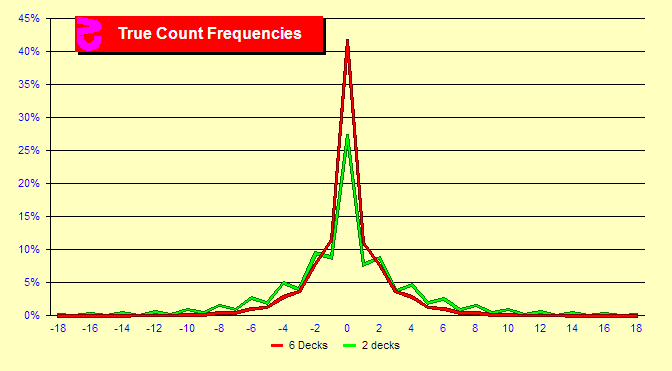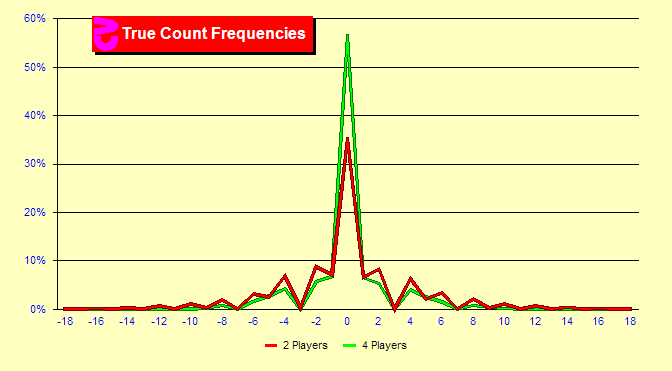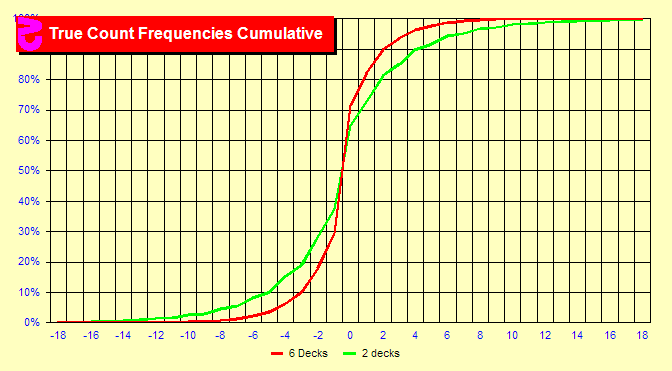|
|
Chapter 2. Data by Count
|
We all know that the count is at the heart of card counting. Each card counting
book tells us this in its own way. But do we fully feel the degree
of impact on everything Blackjack?
"Beware the man of one book." — St. Thomas
Aquinas
| |
 How
often do we get each True Count? How
often do we get each True Count?
The basis of virtually all Blackjack card counting systems is the
count. True counts require adjustment of the count by the undealt
cards and are used by balanced strategies like Hi-Lo, Hi-Opt I, Omega
II, Zen, Uston APC and Revere Point Count. Unbalanced strategies
like KO, Red7 and KISS use the running count and avoid the additional
calculation to find the true count. In this chapter, some charts
will be provided for true counts and running counts — however
not all charts will be provided for running counts.
Let's start by looking at the frequency of true counts. At the
right we see the percentage of hands dealt at each count using Hi-Lo
(one of the most common strategies). Note: There are several methods
of calculating true counts as will be discussed later. Six-deck
frequencies are displayed in red and two-deck frequencies in green.
Obviously the most frequent count by far is zero. It is also clear
that double-deck games experience substantially higher percentages
of high and low counts. You will also see that the red line is much
smoother than the green line. This is because these charts do not
use the exact true counts. Players do not calculate the exact number
of remaining cards when calculating TC. In this chart, remaining
cards are estimated by half-decks. In double-deck games, this results
in lower percentages of odd-numbered counts causing the jagged line
that you see.
|
|
 Single-deck frequencies Single-deck frequencies
Now let us look at single-deck. With only one deck the number of
players becomes very important and can dramatically affect the results.
Here the green line depicts frequencies for four players with two
rounds. The red line displays two players with four rounds. You
will note that with four players a true count of zero is far more
likely. Also note that there are no rounds at TCs of 3, 7 and 9.
Due to the method we use to calculate true counts, some counts cannot
exist in single-deck. When you sit at a single-deck game, be aware
that the number of players substantially affects the game.
|
|
 Cumulative
frequencies Cumulative
frequencies
This chart provides the same data as the first chart, but cumulative.
That is, each point provides the frequency that the count will be
at least the number on the x-axis. We can see that for six decks
(red line) we have a true count of zero or lower about 71% of the
time. Depending on the rules, penetration, strategy, and decks,
the count calls for an increased bet about 10%-35% of the time.
|
|
Sim details
- Six decks, S17, DAS, LS, 4.81/6, Hi-Lo max indexes, trunc, half-deck
- Two decks, H17, DAS, 1.5/2, Hi-Lo Ill18 indexes, trunc, half-deck
- Single-deck, H17, 2 players, 4 rounds, Hi-Lo max indexes, trunc,
quarter-deck
- Single-deck, H17, 4 players, 2 rounds, Hi-Lo max indexes, trunc,
quarter-deck
- Ten billion rounds for six and two decks, five billion rounds
for single-deck
| |
|
|
 How
often do we get each True Count?
How
often do we get each True Count? Single-deck frequencies
Single-deck frequencies Cumulative
frequencies
Cumulative
frequencies